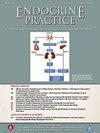Delivery Mode and Neonatal Thyrotropin Levels: Insights From a Systematic Review and Meta-Analysis
IF 4.6
3区 医学
Q2 ENDOCRINOLOGY & METABOLISM
引用次数: 0
Abstract
Background
Optimal thyroid function is particularly crucial during infancy. This systematic review and meta-analysis aimed to investigate the relationship between the mode of delivery and neonatal thyrotropin levels at birth.
Methods
We conducted a systematic search of MEDLINE/PubMed, Web of Science, Embase, Scopus, and the Cochrane Library for studies published up to 2023. Hedges’ g with 95% confidence intervals was calculated to compare mean thyroid-stimulating hormone (TSH) levels based on the mode of delivery. Additionally, TSH levels were compared based on blood sampling methods, heel blood vs cord blood, using the same meta-analytic approach. A random effects model was employed due to the presence of heterogeneity. This study is registered with PROSPERO under the number CRD42024533649.
Results
A total of 1438 studies were identified, of which 18 met the criteria for the systematic review. The meta-analysis of ten studies revealed significantly higher pooled TSH levels in neonates born via vaginal delivery compared to those delivered by cesarean section (Hedges’ g = 0.390; P = .002). In the heel blood subgroup, no significant difference in TSH levels was found between vaginal and cesarean deliveries (Hedges’ g = 0.167; P = .111). However, in the cord blood subgroup, neonates delivered vaginally exhibited significantly higher TSH levels than those delivered by cesarean section (Hedges’ g = 0.493; P = .002).
Conclusion
The study found that the method of delivery has a significant impact on neonatal TSH levels, especially in umbilical cord blood samples, highlighting the need to consider delivery mode in evaluating neonatal health.
分娩方式和新生儿促甲状腺激素水平:来自系统回顾和荟萃分析的见解。
背景:最佳甲状腺功能在婴儿期尤为重要。本系统综述和荟萃分析旨在调查分娩方式与新生儿出生时促甲状腺激素水平之间的关系。方法:我们对MEDLINE/PubMed、Web of Science、Embase、Scopus和Cochrane Library进行了系统检索,检索截至2023年发表的研究。计算95%置信区间(ci)的对冲系数g,以比较基于分娩方式的平均TSH水平。此外,使用相同的荟萃分析方法,根据血液采样方法,脚跟血和脐带血比较TSH水平。由于存在异质性,采用随机效应模型。本研究在普洛斯彼罗注册,注册号为CRD42024533649。结果:共纳入1438项研究,其中18项符合系统评价标准。10项研究的荟萃分析显示,阴道分娩的新生儿总TSH水平明显高于剖宫产分娩的新生儿(Hedges’s g = 0.390;P = 0.002)。在足跟血亚组中,阴道分娩和剖宫产分娩的TSH水平无显著差异(Hedges’s g = 0.167;P = 0.111)。然而,在脐带血亚组中,阴道分娩的新生儿TSH水平明显高于剖宫产分娩的新生儿(Hedges’s g = 0.493;P = 0.002。结论:本研究发现,分娩方式对新生儿TSH水平有显著影响,尤其是脐带血样本中TSH水平,强调在评估新生儿健康时需要考虑分娩方式。
本文章由计算机程序翻译,如有差异,请以英文原文为准。
求助全文
约1分钟内获得全文
求助全文
来源期刊

Endocrine Practice
ENDOCRINOLOGY & METABOLISM-
CiteScore
7.60
自引率
2.40%
发文量
546
审稿时长
41 days
期刊介绍:
Endocrine Practice (ISSN: 1530-891X), a peer-reviewed journal published twelve times a year, is the official journal of the American Association of Clinical Endocrinologists (AACE). The primary mission of Endocrine Practice is to enhance the health care of patients with endocrine diseases through continuing education of practicing endocrinologists.
 求助内容:
求助内容: 应助结果提醒方式:
应助结果提醒方式:


